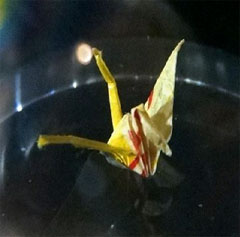| The Public Paperfolding History Project
x |
|||||||
| The paperfolding of Sadako Sasaki | |||||||
1945 onwards In November 1954 an eleven year old Japanese girl from Hiroshima, called Sadako Sasaki, who had been just two at the time the USA had dropped an atomic bomb on that city in 1945, but who had survived because her family lived sufficiently far from the centre of the explosion, began to show signs of radiation sickness and was admitted to hospital. On August 3rd 1955 a number of paper cranes folded by well-wishers in Nagoya were sent to the hospital. Sadako began to fold her own cranes, symbolising her desire to get well. Sadako threaded the paper cranes she folded together into strings and hung them from the ceiling of her room in the hospital. By the end of August Sadako had folded 1,000 paper cranes, but she continued to fold more. Her condition continued to deteriorate and she died on October 25th 1955 having by then folded over 1300 paper cranes. Within three years of her death sufficient money had been raised to build a memorial to her in Hiroshima Peace Park. (Information from the website of the Hiroshima City virtual museum.) The story of Sadako has been told in the West in a number of books and films, not all of which are very true to the facts. The earliest book to mention her, although only briefly, was 'Strahlen Aus Der Asche' written by the Austrian journalist Robert Jungk who had visited Hiroshima in 1956 and heard Sadako's story from a family friend called Kawamoto. He gives the number of paper cranes that Sadako folded as only 644 (p161 of the English translation entitled 'Children of the Ashes'). Another Austrian, Karl Bruckner, published the children's book 'Sadako Will Leben' in 1961. This book was translated into English as 'The Day of the Bomb'. It is a fictionalised and romanticised account of Sadako's life and death and gives the number of cranes she folded as 990. Another children's book, also giving a fictionalised and romanticised account, titled 'Sadako and the Thousand Paper Cranes' was published in 1977 by the Canadian born author Eleanor Coerr. Following Jungk, the number of cranes Sadako folded before her death is given as 644.
A paper crane folded by Sadako Sasaki from a sweet wrapper Folding and stringing together a thousand paper cranes has become a common way to express a general desire for peace, or a more specific hope that nuclear weapons should never again be used, and many such strings are sent every year to the Hiroshima Peace Park to be displayed on or near Sadako's monument. Strings of a thousand paper cranes are also sometimes made as a more personal expression of good wishes for those who are unwell or dying. It is not altogether clear whether these various practices are a continuation of a pre-existing Japanese tradition or something completely new that has arisen as a result of the popularisation of Sadako Sasaki's story. ********** |
|||||||
